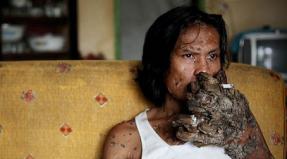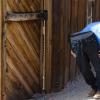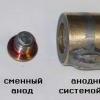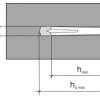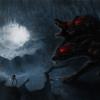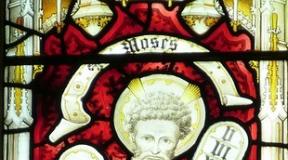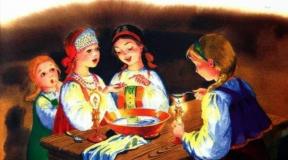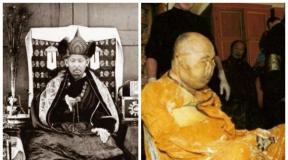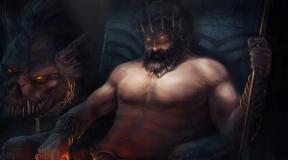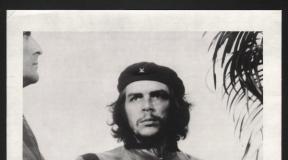Flag of the Hitler Youth. "Hitler Youth": how underage soldiers of Hitler fought. Hitler on the Hitler Youth
12th SS Panzer Division "Hitlerjugend" (12. SS-Panzer-Division "Hitlerjugend").
This unit owes its formation to the SS Gruppenführer Gottlob Berger, who proposed to the SS Reichsfuehrer Heinrich Himmler, in January 1943, to create an SS division from members of the Hitler Youth. On February 10, 1943, a decree was issued according to which the formation of the SS division "Hitler Youth" was allowed from conscripts born in 1926 (age - 17 years old, earlier for volunteers entering the SS there was an age limit of 23 years). SS Oberführer Fritz Witt of the Leibstandarte-SS Adolf Hitler was appointed division commander, who also provided other personnel for the newly formed units. Through the competition, a distinguishing mark of the division was established, on which the Sowilo rune (the symbol of the Hitler Youth organization) crossed with a master key (the sign of the SS division "Leibstandarte-SS Adolf Hitler", which arose from the name of its first commander Joseph Dietrich (German: Dietrich - master key) ).
Fritz Witt
The construction of the tankers of the division during its inspection by Field Marshal Gerd von Rundsted, France, January 1944. 
Captured German soldiers from the 12th SS Panzer Division "Hitler Youth" under the escort of the military police of the 3rd US Army. These child soldiers (aged 16 and 17) were taken prisoner on the outskirts of Magerotte, east of Bastogne, Belgium. 

Until September 1, 1943, more than 16 thousand members of the Hitler Youth were called up, who underwent six months of training. In addition, more than 1 thousand veterans of the SS troops, as well as experienced officers from the Wehrmacht, were transferred to the division. The total number of personnel exceeded 20 thousand people with 150 tanks. During training in Beverloo (Belgium), it was decided to reorganize the original Panzergrenadier Division into a Panzer Division and change its name to the SS Panzer Division "Hitler Youth". When the units of the Waffen-SS were renumbered on October 22, 1943, the division received the number 12, and its grenadier regiments - the numbers 25 and 26.
Since June 1944, the division was on the Western Front in Normandy.
Grenadier of the 12th SS Panzer Division "Hitler Youth" on the road to Orne (Orne), Nomandy.
On June 6, 1944, the Allies launched the Normandy invasion with Operation Overlord. The 12th SS division "Hitler Youth", together with the 21st Panzer Division, were the tank units closest to the landing site. However, due to air raids, they reached the battlefield only at about 22:00 near Evresi.
On June 7, the 25th SS Panzergrenadier Regiment under the command of SS Standartenführer Kurt Meyer, together with the 12th SS Panzer Regiment, managed to repel the attack of the Canadians, and 28 tanks were destroyed, and the Nova Scotia Highlanders infantry regiment suffered heavy losses. In this case, the losses of the division amounted to six people. During this operation, 20 Canadian prisoners of war were killed by soldiers of the division in Abbaye d "Ardenne.
Kurt Meyer
On June 8, the 26th SS Panzergrenadier Regiment under the command of SS Obersturmbannführer Wilhelm Mohnke reached a position west of the Meyer regiment. The regiment struck in the direction of Saint-Manvieux-Norre and captured a strategically important village.
Two tanks M4 "Sherman" squadron "A" of the 2nd Canadian Panzer Division, shot down and burned down on June 11, 1944 on the street of the French town of Ro (Rots) during the battle with the 12th SS Panzer Regiment of the 12th SS Panzer Division "Hitler Youth" ". 

Captured soldiers of the 12th SS division "Hitlerjugend" (12. SS-Panzer-Division "Hitlerjugend") at lunch in a field near the French town of Ro (Rots). 
On 14 June, the Royal Navy bombarded the position at Venoix, killing Witt. His place was taken by Kurt Meyer, who became the youngest division commander of the Second World War (33 years old). Meyer was later accused of committing war crimes, as he demanded that his units not take prisoners.
The division was ordered to capture Caen within the next four weeks, although it was heavily outnumbered by the enemy and air support was lacking.
Panzergrenadier of the 12th SS Panzer Division "Hitler Youth", captured by Canadian reconnaissance during the Battle of Caen. August 9, 1944 
Tank Pz.Kpfw. IV (Panzerkampfwagen IV, Ausf. H, tail number 626) of the 6th company of the 12th tank regiment of the 12th SS Panzer Division "Hitler Youth" (6.Kompanie / SS-Panzer-Regiment 12 / 12.SS-Panzer-Division "Hitlerjugend") on the march along the street of the French city of Caen (Caen).

Another tank Pz.Kpfw.IV with tactical number 625 from the same company of the 12th SS Panzer Division "Hitler Youth".
In the first weeks of July, the division suffered heavy losses. Therefore, Meyer ignored the order to hold the northern border of Caen and retreated with the remnants of his troops to the south. By this time, the division had lost 4,000 men killed, 8,000 wounded and a large number missing.
A machine gunner from the 12th SS Panzer Division "Hitler Youth" fires at the enemy with an MG-42 machine gun. France, July 1944. 
Eighteen-year-old SS Sturmmann (corporal) Otto Funk (Otto Funk) from the 25th Grenadier Regiment of the 12th SS Panzer Division "Hitler Youth" in Ro (Rots) after the failed German attack on Norre-en-Bessin (Norrey-en-Bessin), northwest of Caen, France.
On June 26, 1944, Otto Funk (06/06/1926-09/11/2011) was wounded in the Cheux area, on May 8, 1945 he surrendered to units of the 65th US Infantry Division in Enns, Austria. 
Rewarding the soldiers of the division for the June-July battles in Normandy
By August 17, the main forces of the division fell into the Falaise pocket, where they operated north of the city of Falaise. On August 29, the remnants of the division managed to break out of the encirclement, while losing about 9 thousand people since June 6, almost all tanks and most of the heavy weapons and equipment. Until September, the personnel decreased by another 2 thousand people and amounted to about 3 thousand people. Meyer himself was captured on September 6 by Belgian partisans, as a result of which SS-Obersturmbannführer Hubert Meyer took command. Continuing the retreat, the division passed through Vielsalm and Malmedy. Having reached the Western Defensive Wall, the division took part in the defense of the canal and the Eifel region.
In November, the division was transferred to Nienburg, where, in view of the actual destruction, it was re-formed. Meyer was replaced by SS-Obersturmbannführer Hugo Kraas. The division was assigned to the 6th SS Panzer Army under the command of SS-Oberstgruppenführer Sepp Dietrich to participate in Operation Watch on the Rhine.
Tank M4 "Sherman" (board number 14) of the Canadian regiment "Sherbrooke Fusiliers" (Sherbrooke Fusiliers) and soldiers of the regiment "Fusiliers Mont-Royal" (Les Fusiliers Mont-Royal) in battle with a group of SS Sturmbannführer Krause (Kampfgruppe Krause) 12th SS Panzer Division Hitlerjugend (12. SS-Panzer-Division Hitlerjugend) on French Falaise Street. 
Captured soldiers of the 12th SS Panzer Division "Hitler Youth", captured in the Falaise pocket.
The operation, which began on December 16, 1944, despite all efforts, did not achieve its goal - to break through the enemy's defenses. The reason was the strong resistance of the opposing American troops. Following this, the division was withdrawn to take part in the siege of Bastogne. Until January 18, 1945, the division, like other German units, was pushed back to its original positions.
Grenadiers of the 25th Panzergrenadier Regiment (SS-Panzergrenadier Regiment 25) of the 12th SS Panzer Division "Hitlerjugend" (12. SS-Panzer-Division Hitlerjugend), killed in battle with the 509th Parachute Regiment of the US Army on December 26, 1944 during offensive in the Ardennes. 
Captured young German soldiers of the 12th SS Panzer Division "Hitler Youth", captured by soldiers of the 7th US Army in the city of Schillersdorf, France. 
Captured soldiers of the 12th SS division "Hitlerjugend" (12. SS-Panzer-Division "Hitlerjugend") loaded the wounded into the back of an American GMC truck 
Captured soldiers of the 12th SS Panzer Division "Hitler Youth".
On January 20, 1945, the 6th SS Panzer Army received an order to redeploy to eastern Hungary to take part in the battles for Budapest, where 45 thousand people of the 9th SS mountain corps were surrounded. The transfer of units began on February 2, and already on February 4, the first units arrived in the area south of Kolta. On February 5, the division went on the offensive near the city of Gran on the Danube. By the end of the month, the bridgehead at Gran was eliminated. Then the SS Panzer Division "Hitler Youth" participated in the battles for the Paris Canal, Barth and Beni.
Subsequently, the division took part in the offensive on Lake Balaton, during which Germany planned to regain oil fields. Parts of the division operated near the eastern part of Lake Balaton. Hitler tried to keep this operation secret and ordered no reconnaissance of the battlefield before the start of the offensive. After initial success, the operation was interrupted by a Soviet counteroffensive.
The German tank Pz.Kpfw. destroyed near Lake Balaton. V Ausf.G "Panther" from the 12th SS Panzer Division "Hitler Youth". Late production vehicle, gun mantlet with a kind of tide in the lower part - a “beard”, which makes it impossible for the turret to jam when a projectile hits, and also prevents the projectile from ricocheting into the turret plate. The car's gun barrel was shot through. The number of the Soviet trophy team is "79". 
After March 15, the Hitler Youth division began a retreat along the Veszprem-Papa-Raba route. Having crossed Raba and Sopron, the remnants of the division moved at an accelerated march towards the advancing American troops deep into Austria. After passing Enns, the remnants of the division surrendered to the troops of the 65th Infantry Division of the 7th US Army on May 8, 1945. Of the 21,300 personnel in the division as of December 1943, 455 soldiers and officers survived. The division retained one tank.
“I learned with joy and pride of your desire to go to the front as volunteers with the entire class of 1928 born. At this decisive hour for the Reich, when the threat of a hated enemy loomed over us, you gave us all an inspiring example of fighting spirit and reckless devotion to the cause of victory, which "The youth of our National Socialist movement, both in the rear and at the front, met all the expectations of the nation. Your volunteers have given us the clearest proof of their devotion and unshakable will to win by serving in the units of the Hitler Youth" , "Grossdeutschland" and Volksgrenadiers, as well as fighters in all branches of the armed forces.
The understanding of the need for this struggle today overwhelms the minds and hearts of the entire German nation, and especially the youth. We know the enemy's plans for the ruthless destruction of Germany. It is for this reason that we will fight even more devotedly in the name of a Reich in which you can work and live with honor. However, as young fighters of National Socialism, you must show, even more than the rest of the nation, your endurance, perseverance and steadfastness. The sacrifices made by our heroic young generation will be embodied in a victory that will ensure the proud and free development of our people, the National Socialist Reich."
“Officially, it was possible to enlist in the military service only at the age of 19. At the same time, volunteers were also accepted at the age of seventeen. However, the war made its own adjustments to the established procedure. In 1941/1942, eighteen-year-olds were drafted. and sixteen-year-olds began to be taken in 1945. In 1944, sixteen-year-old teenagers born in 1928 could join the army on a voluntary basis.
In February / March 1945, young men born in 1928 were drafted into the Wehrmacht and the SS troops. In addition to them, sixteen-year-old schoolchildren were also recruited into the troops. At Bormann's request, Hitler ordered about 6,000 youths born in 1929 to be called up to reinforce the Volkssturm detachments on the second line of defense. General Field Marshal Keitel also gave the order to begin conscription from among those born in 1929."
A young German prisoner captured in France

Under the escort of two American soldiers. 12.1944

Everything! End!

A prisoner on the street of the German village of Lemgo. 1945

Soldiers captured by the US 44th Infantry Division. France

Apparently studying a personal document

An American soldier searches a captured German anti-aircraft gunner. 1945

Mercy to the enemy. Reclaimed, brat...

Prisoners of the 12th SS Panzer Division "Hitler Youth", captured by soldiers of the US Army, France

Prisoners of the 12th SS Panzer Division "Hitler Youth" under escort of the US military police. Ardennes. 12.1944

To the photo above

Reich's "Last Hope"

Captured German "tank destroyers" from the Hitler Youth. 04/07/1945
“For the “jungman” Gerd Ekkehard Lorenz, the beginning of the end came on April 19, 1945. His platoon was sent from Potsdam to Spandau, where Heismeyer settled. The youths rode bicycles. They were hung with weapons: faustpatrons, carbines and machine guns. Heismeyer met them at the "stronghold of Radeland," as the boarding school in Spandau was now called. Five days later, the "games" ended and the war appeared in its terrible guise before Lorenz and his comrades.
This was not the first combat operation of the Jungmans. Before her, they had already once fired at the Red Army, hiding in the forest, and returned without loss. However, on April 24, 1945, they experienced an event that shook them. The pupils took up a position that the German soldiers had left shortly before. In the trenches lay the corpses of young Luftwaffe soldiers and anti-aircraft gunners, pierced by Russian four-sided bayonets. The sight of the mutilated bodies brought the young men into a state of shock. The "Jungmans" have never seen dead people. “None of us dared to speak loudly,” recalls Lorenz. - Really, and we will soon also have to lie on the ground? Photographs lay next to the corpses. Mothers, sisters, friends? The pupils still believed that the twelfth army of General Wenck would break through the encirclement around Berlin and turn the tide of the battle. Heismeyer promised them this. “You only need to hold out for 24 hours,” Hans Müncheberg recalls Heismeier’s words. The Fuhrer is in Berlin. You must be faithful to him. Wenk's army is on its way. Another 24 hours, maximum 48 hours, and fate will change.”
The next morning began with a powerful artillery barrage. Then rocket launchers roared, called "Stalin's organs." The fifth platoon of the national political boarding school from Potsdam came under fire. The Jungmans were surrounded. Toward evening, through the crackle of machine guns and grenade explosions, screams and groans were heard. Their tutor Otto Möller was seriously wounded. His legs were shattered by grenade fragments. He asked for morphine: "Have pity on me, give me morphine!"
There were various rumors. Wenk's army is about to come. Allegedly, selected Stalinist troops were thrown against her. Someone said that Heismeier, with his wife Gertrud Schlotz Klink, head of the German women's union, headed west and left the pupils to their fate.
On the night of April 26, the Jungmans from the Heismeyer Group attempted to break through. Lorenz and his comrades made their way towards the Gatov airfield. The airfield was already surrounded and fired upon by the Russians. Some of the pupils went on a breakthrough again. In the confusion of the last battles, they lost each other. During the defense of Berlin, every third "jungman" from the fifth platoon of the national political boarding school in Potsdam was killed. Corrupted, deceived, destroyed. “It was impossible to give up. One could only die, ”says Harald Schlotz, a former student of Adolf Hitler’s school. He was then 15 years old.
Pupils of schools bearing the name of Hitler considered it their duty to "die like knights against death and the devil" in the "last battle". One of them wrote on February 11, 1945: “Ten days ago I left my homeland and have been fighting ever since. We knocked out Ivanov from one village nearby. The guys from the Hitler Youth were advancing with us. There were 40-60 of them. They joined us voluntarily. Basically, these were guys from the school of Adolf Hitler from Warta and the teacher's school. I enjoyed watching them during the attack. They ran, jumped, fired and were always ahead. The militia lagged behind them by 200 meters. Our guys sang and shouted "Hurrah" during the attack. Many died. The youngest were fourteen and a half years old. This is how we embody our ideals.”
A photograph of Hitler, found in the pocket of one of the murdered students, was inscribed: "When others hesitate, we believe you even more." Fanaticism led them to their own death. Two students of the school of Adolf Hitler were thrown behind enemy lines on February 21, 1945 in Nordifel. The SS gave the young men a radio transmitter. They were supposed to report intelligence to the Wehrmacht command about British and American forces in this front-line area. Fierce fighting broke out near the "Ordensburg" Vogelsang for a dam on the Urft River. Already on the second day after being thrown into the rear, both "partisans" were captured by an American patrol. Initially, they were sent to a prisoner of war camp near Aachen. There they were court-martialed by the Ninth American Army. The attitude of the Americans to the "Werwolf" (the so-called Germans left in the rear of the allies for subversive work) was unequivocal. The verdict read: Death by firing squad on charges of espionage.
The youths were transferred to a prison in Aachen itself. Their defender, an American officer, insisted on pardon. Weeks then dragged on, waiting for the final verdict. The prisoners were transferred on May 30, 1945 to Braunschweig, on May 31, a representative of the American military court announced to them that the pardon was rejected, and the execution was scheduled for 10 a.m. the next day.
The Americans allowed young men to write farewell letters to their parents. One of them, named Franz, tried to explain to his parents the reasons that pushed him to carry out this mission in Nordeifel: “I did not do this for the government, which deceived and betrayed us. I did this in the deep hope that by doing so I would serve my beloved German homeland and my people.” The letter also said that he was proud of the opportunity to die for Germany, and not for Goebbels and Himmler. The letter ended like this: “The priest has already come to us. I'm ready for anything. After two months of my imprisonment, I understood what it means to believe in the Lord. One can say; there is someone next to you, someone who can console you in a huge trouble, when none of the people is already able to help.
On Sunday morning, June 1, 1945, the execution took place. American soldiers tied the condemned to poles at the bottom of an abandoned quarry near Braunschweig. The coffins were already prepared. At exactly 10 a.m., a volley of firing squads rang out. Franz was 16 years and 5 months old, his friend Herbert was 17 years old.
Together with the collapse of the Nazi Reich, all the dreams and hopes of the "future Fuhrers" collapsed. “A whole world collapsed around me and inside me,” recalls Hans Bucholz, who studied at a boarding school in Naumburg, “everything that was of value to me suddenly disappeared somewhere. The people I looked up to with adoration turned into criminals. The ideas for which I lived and for which I was ready to die turned out to be criminal.” Hitler's suicide was a blow to many and at the same time removed the veil from their eyes. “I howled like a yard dog,” admits Hans Müncheberg.

An elderly Frenchman shakes his fist at the captured young soldiers of the SS troops. 1944

"Soldiers" taken prisoner by the US 6th Panzer Division in Giessen. 03/29/1945

Presumably a Hitler Youth. 04.1945

Teenagers from the Hitler Youth, taken prisoner by soldiers of the US Army. Spring 1945

Captured 14-year-old German soldiers from the Hitler Youth. Bershtadt. 04.1945

Captured German soldiers of the 716th division of the Wehrmacht. Normandy. 1944

A group of captured Wehrmacht soldiers near Münster. Germany. 04/19/1945

Lucky. Survived

"Command"

Prisoners from the 352nd division who surrendered to the allies in the city of Merzig. Luxembourg. 1944

German prisoners from the SS division "Dead Head" ("Totenkopf"). France, 1944

German anti-aircraft gunners captured by units of the 9th US Panzer Division in the spring of 1945. Germany

Captured German teenagers. Spring 1945

The boy, presumably from ours, but I don’t have exact information

Warrior...

Captured 15-year-old German anti-aircraft gunner Hans-Georg Henke

Scary?

Very scary!

Defenders of Berlin
"Already in the conditions of the collapse of the Nazi empire, the call for "volunteers" of 15-16 years of age began to take place. From these schoolchildren, detachments" werewolf "(werewolves) were formed. They had to fight to the last breath. They were instructed to cover the withdrawal of Wehrmacht units, to carry out sabotage acts in the rear of the troops of the anti-Hitler coalition.Even after the surrender of Nazi Germany, some "werewolves", among which there were even 14-year-old teenagers, continued to carry out their combat missions, because they did not receive an order to cancel them.One of these battles was described by the famous Soviet journalist M. Merzhanov, who in those days was a correspondent for the Pravda newspaper:
“Suddenly, a bell rang at the command post of the regiment commander. The battalion commander reported that about 400 youngsters were moving in orderly order along Kolonenstrasse, dressed in black school tunics with gold buttons and black trousers. the names of Hitler, Goebbels, Goering, as they pronounce the names of saints, raising their hands to the sky.They walked beating a step and holding faustpatrons at the ready... These are the suicide bombers of Arthur Axman, fanatics who decided to give their lives for the Fuhrer, went on a "psychic attack", believing that they will scare the Soviet soldiers.
How to be? - asks the battalion commander. - Let them through to the rear or open fire on them?
Refrain, - answered the regiment commander, - find a way to disarm ...
Meanwhile, the youths were approaching. The battalion commander fired several yellow rockets - a signal indicating the leading edge of the front. But in response, the youngsters, having come close, began to throw faustpatrons (? shoot from them at Soviet positions - A.V.) There were wounded, killed. The boys with wild eyes rushed into hand-to-hand combat. I had to open fire. For several minutes, because of the smoke and indiscriminate shooting, nothing could be understood, and then the youths, throwing faustpatrons, began to run to their rear.
The wounded schoolchildren, crying, during interrogation told how they were led into battle by the head of the district committee, who assured that Tempelhof was easy to take back ... "

War is over...

Soldiers of the American army show the bodies of prisoners in a wagon in the Dachau concentration camp to teenagers from the Hitler Youth
1. Start.
Founded in 1926 as a youth division of the SA (storm troopers), this organization was first called the NSDAP Youth League (Jugendbund,NSDAP). Name "Hitler Youth" (Hitler-youth) she received a little later, at the party congress. In 1940 it consisted of eight million young Nazis*.
2. Their books.
Covers of children's books from the series "Military Education of German Youth". A very peculiar concept of patriotism.
3. "Only for the Aryans"
Created on a military model, the organization covered German youth aged 10 to 18 and was divided into clear age categories. Junior group: boys from 10 to 14 years old - "German Youth" (Deutsches Jungvolk-DJ) 14 to 18 years - Hitler Youth proper (Hitler-youth-HJ). Women's organization as part of the "Hitler Youth": girls aged 10 to 14 years - "Union of Girls" ( Jungmadelbund,JM)
; from 14 to 18 years old - "Union of German Girls" ( Bund DeutscherMadel - BdM).
You can join the Hitler Youth from the age of ten, and from April 1939 such entry becomes mandatory, of course, only for racially full-fledged ones. Every year, on March 15, those who have grown to ten years old are registered at the Imperial Youth Headquarters. After checking for "racial purity" - we get a piece of paper - "free from shame" (!), Then - "trials of boys" and a medical examination. And finally - the solemn procedure for admission to the junior group - "jungvolk", on April 20, the Fuhrer's birthday. You are pimpf (pimpf).
4. Magazine covers "D"erpimpf".
Funny pictures for "Jungfolk".
"Test of the boys": run 60 meters in 12 seconds, jump 2.75 m in length, throw a ball at a distance of at least 25 m, be able to fold a hiking backpack, take part in a camping trip with an overnight stay. And sing "the song of Horst Wessel."
5. Their posters.
How psychologically precisely the trap is built! You will be taught to shoot, drive a car, you will pass the standards for a sports badge - you will receive a driver's license. And what boy does not dream of a knife! And they will give you not just a knife - a bayonet-knife! Its hilt is a copy of an army bayonet. Here he is! And what is the inscription on the blade - "Blood and honor." The SS presented the Hitler Youth with one of its two "zig" runes - symbols of future victory. Then the jokes are over. Blood and honor is the price you have to pay for the tsatski that the unkind uncles in brown and black uniforms hung on you.
6. Knife.
7. What were they taught?
At the age of 15 - joining the Hitler Youth and preparing for future military service. Since 1937 - firing a firearm, driving a car, piloting a glider, even piloting a small ship or aircraft and combat tactics in small detachments. From the age of 19 - a mandatory 6-month labor service in labor camps, where they mastered the profession and taught iron discipline. This was followed by a 2-3-year service in the Wehrmacht. With the beginning of the war - air defense measures and fire fighting. By the end of September 1939, more than a million members of the Hitler Youth were employed in auxiliary positions in the Wehrmacht system.
Under vigilant Nazi control, all young people were from 10 to 21 years old, practically cut off from their families.
8. Their shape. Isn't that what they want to introduce in our schools?
"This youth - they will not learn anything else but to think in German, act in German. And when these boys and girls come to our organizations at the age of ten - only there they get and feel fresh air for the first time, in four years they get from the Jungvolk to the Hitler Youth, we [...] accept them into the party or the Labor Front, into the SA or the SS. And if they [...] do not become perfect National Socialists, then they will be drafted into the Labor duty "and they will polish their skills for six to seven months with the help of another symbol - the German spade! And what remains of their class consciousness or class arrogance in six or seven months will be taken care of by the Wehrmacht in the next two years. And when they they will return [...] we will take them to the SA, SS, so that in no case will they take up the old.
And they will never be free again - all their lives!"
From A. Hitler's speech in Reichenberg, 1938
9. Badges of the Hitler Youth.
Very high workmanship - "bundmetal", hot enamel. You immediately understand why they called their Reich a thousand years old.
10. In combat.
Since 1943, the recruitment of 17-year-olds to the Wehrmacht and their direct participation in battles began. However, the most radical and dramatic episode was the decision of 17- and 18-year-old youths to serve in the 12th SS division "Hitler Youth". The young fanatics fought harder than the veterans, and in less than a month the division lost 60% of its personnel, escaping from the Falaise cauldron with battles.
12
SS-
Panzer-
division"
Hitlerjugend"
(12th SS Panzer Division "Hitler Youth").
Formed from volunteers of the youth draft in 1943. The first battles are in the area of Caen and Falaise, France. After reorganization - participation in the Ardennes operation. In January 1945, she was relocated to Hungary, retreated to Austria. Of the initial composition of 21 thousand 300 people on May 8, 455 surrendered to the Americans. With the only surviving tank.
"UnusualAino active, domineering, violent youth - that's what I will leave behind. In our knightly castles we growm youth, before which the world will shudder [...] Youth should be indifferent to pain. There should be no weakness or tenderness in it. I want to see in her gaze the brilliance of a predatory beast [...]"
Adolf Gitler.
11. Captivity.
12. From history - Crusade of children.
In 1212, at the height of the Crusades, the French shepherdess Stephen of Cloix had a vision - Jesus himself appeared to him and ordered him to lead a new Crusade, in which only children would take part, so that without weapons, with the name of God on their lips, to conquer that which is not possible for adults. Little children will come to the Holy Land, the pagans, seeing them, will be ashamed and immediately give it to the Christians - an absolutely brilliant plan. Thirty thousand children from all over France gathered at Vendôme to go to Palestine. Pope Innocent III was delighted: "Children watch while we sleep!" he exclaimed. The children from Germany had the worst of all, there were about twenty-five thousand of them - when crossing the snow-covered Alps, most of them died. Good merchants, having learned about the children, donated their ships for their delivery to Jerusalem. True, the ships sailed to the shores of Algeria, where the children were sold into slavery ...
Original
*Data from website:
The Hitler Youth is a youth organization under the NSDAP, which was officially formed in 1926. The organization was headed by the Reichsugendführer, who reported directly to Adolf Hitler. Initially, it was voluntary, but after the Nazis came to power, it became mandatory for all male teenagers. The Hitler Youth had branches not only throughout Germany and in the countries conquered by the Germans, but also in the Axis powers - in Italy and Japan. During the Second World War, especially at its final stage, the Nazi regime decided to use the organization for military purposes. Initially, the younger Hitler Youth worked in the rear, and their older comrades were called to the front. But at the final stage of the war, they began to put everyone without exception under arms. The organization ceased to exist immediately after the defeat of Germany, along with the dissolution of the Nazi Party.
At present, one of the most little-studied and little-known pages of the world war concerns the role of participation in hostilities of children and adolescents. One often hears that the Soviet government and Stalin exterminated their own people, and Hitler and the Germans destroyed other peoples, but it was the Hitler regime that threw children and teenagers into the millstones of the war. In the Red Army, the draft age began at the age of 18. Even in the most difficult years of the war for the Soviet Union, there was no reduction in the draft age. Only the last draft in 1944 began at the age of 17, but the teenagers drafted at this age basically did not take part in the battles, being used only in the rear in numerous auxiliary detachments and subunits.
Even in the most difficult months of the Great Patriotic War for the USSR, when German troops stood at the gates of Moscow and on the Volga, the draft age in the Red Army did not go down. A completely different situation was observed in Germany. And although the draft age in the Wehrmacht did not officially fall below 18 years, it was the German military units that took part in the hostilities that consisted of 16-17-year-old teenagers, and at the very end of the war, even 12-year-old children could be found on the fronts.
At the same time, it is much easier for adults to bring children to a state of mindless submission and force them to fight fearlessly. Children are good fighters because they are young and eager to show themselves. They believe that what is happening is some kind of game, which is why they are often so fearless. All this was fully characteristic of the pupils of the Hitler Youth and those who, at the end of World War II, ended up in Volkssturm units or werewolf detachments (German militia for partisan warfare). As a result, even experienced Soviet front-line soldiers were often surprised by the fearlessness and militancy that the German youth demonstrated. Often these teenage soldiers threw themselves under the tanks.
With fanatical tenacity, they could burn Soviet and allied tanks, shoot and shoot down planes as part of anti-aircraft crews, shoot unarmed captured soldiers, and some especially fanatical ones continued fighting after May 9, 1945, shooting front-line soldiers from ambush. Children and adolescents were often more violent than adults. Today, this is still confirmed, but already in Africa, where a huge number of children, sometimes as young as 8 years old, fight in various paramilitary groups, who do not feel any pity for their enemies.
At the same time, little documentary evidence of war crimes that would have been committed by underage soldiers of the Wehrmacht and SS troops from among the pupils of the Hitler Youth during the Second World War has survived. There are two explanations for this - the juvenile delinquents themselves did not want to remember and brag about their "exploits" during the war years. In addition, there was an unspoken taboo on the dissemination of such information in the USSR, and children and adolescents themselves were recognized as victims of the Nazi regime.

There was really little evidence of crime. So, for example, one of them refers to the memoirs of Lieutenant Colonel of the Allied Forces Robert Daniel and concerns the liberation of the Bergen-Belsen concentration camp. It is perhaps the only documentary evidence of the crimes committed by underage Nazis. According to the officer's recollections, he heard the sounds of gunshots and approached the fence of the concentration camp. There were four young SS men or even students of the Hitler Youth, they all looked very young. All of them shot at living people and corpses, while diligently aimed at men and women in the crotch, trying to cause them maximum pain. Robert Daniel shot three of them, and the fourth managed to escape. What happened to that “fourth”, how his fate turned out, and what kind of life he lived, now hardly anyone will know. But the fate of some members of the Hitler Youth is known to historians quite well.
To the popes and to the communists
For example, the previous Pope Benedict XVI in the world was called Josef Alois Ratzinger. In 1941, at the age of 14, he joined the Hitler Youth, and later served in the anti-aircraft and anti-tank defense units and in the infantry. A few days before Germany announced its surrender, he deserted and spent some time after the end of the war in an American prisoner of war camp. After his release from the camp, Josef Ratzinger changed his life dramatically by entering a theological seminary and was ordained in 1951. In 1977 he became a cardinal and then head of the Congregation for the Doctrine of the Faith. In 2005, after the death of John Paul II, he became the new pope.
Konstantin Alexandrovich Zalessky, an employee of the Russian Institute for Strategic Studies and a military historian, notes that the fate of Joseph Ratzinger is not only unique, but also to some extent typical for German teenagers during the war. German children who were drugged by Nazi propaganda in the Hitler Youth and, participating in armed resistance to the Allied forces on the Eastern and Western Fronts, became, in fact, the victims of that war. Already matured, many of them were able to reconsider their views on the "Greater Germany".

Pope Benedict XVI
The fate of another famous German teenager, Alfred Cech, who was born in 1933, is also indicative. He was a member of the Jungvolk organization (a division of the Hitler Youth for teenagers under the age of 14). On April 20, 1945, this German boy was awarded the Iron Cross by Hitler himself, he received an award for rescuing wounded German soldiers from the fire of the Soviet army. After the award, he was immediately sent to accelerated courses in handling, and later to the front, where he spent the last weeks of the war. Not having fought even a month, he was wounded and ended up in a prisoner of war camp, where he spent 2 years.
After returning home, he discovered that he would no longer live in Germany. His hometown of Goldenau was ceded to Poland. Growing up, a former member of the Hitler Youth, who received an award from Hitler, joined the Communist Party (who would have believed this even in 1945!). True, he did this in order to be able to emigrate to West Germany, where he worked for the rest of his life as a construction worker. He had 10 children and over 20 grandchildren.

Alfred Cech - the youngest holder of the Iron Cross 2nd class
German teenagers go to war
The defeat in the Battle of Stalingrad was one of the reasons for the involvement of members of the youth organization of the Hitler Youth in armed resistance to the advancing units of the Red Army and its allies - the United States and Great Britain. Already in January 1943, a service of German youth of pre-conscription age was established. Most often, it was about high school students who were recruited to serve in anti-aircraft artillery units by entire units of the Hitler Youth under the command of their "Jugendfuehrers". Such teenagers were considered persons performing "youth service", and not real soldiers, although they actually served in the Wehrmacht. They also allowed sending adult anti-aircraft gunners to the front.
Apparently, these were the "cheapest" soldiers in the Nazi army. Until they reached the age of 16, they received only 50 pfennigs for each day of service, and after reaching 16 years of age - 20 marks per month. In the final months of World War II, even girls began to be recruited to serve in air defense units. German teenagers were also recruited to serve in the Air Force, where in 1944 there were already 92,000 young men who were sent here from the Hitler Youth, and teenagers were also used in the navy.
From the end of 1944, Adolf Hitler authorized total mobilization in Germany. According to the personal order of the Fuhrer of October 18, 1944, the entire male population aged 16 to 60 who is not in military service is subject to mobilization. By May 1945, approximately 700 Volkssturm battalions were formed in Germany, which acted on the front lines against the Soviet troops. On the Eastern Front, some of these detachments offered fierce resistance to the advancing units of the Red Army. Volkssturm fighters distinguished themselves in the battles for the Prussian village of Noendorf in November 1944. Their resistance was no less fierce in Bresslau, which, together with parts of the Wehrmacht, they defended from January to May 1945, the garrison of the city capitulated only on May 6, 1945.

Already since 1944, 16-year-old German boys went to the slaughterhouse for the sake of their Fuhrer. But this threshold did not last long, and soon the Hitler Youth sent 12-15-year-old German children into battle. At the final stage of the war in Germany, they began to organize detachments of Verolfs, who were supposed to carry out sabotage in the rear of the Allied troops and wage a guerrilla war. Even after Germany capitulated and the war was over, some "werewolves", among whom were many children over the age of 14, continued to carry out their combat missions, as they did not receive an order to cancel them. At the same time, the fight against individual "werewolves" in East Germany and a number of other countries of Eastern Europe continued almost until the beginning of the 1950s. Even while suffering a final defeat in the war, the Nazi regime dragged tens of thousands of lives of children and adolescents into oblivion.
12th SS Panzer Division "Hitler Youth"
One of the divisions of the German army, which was entirely formed from the pupils of the Hitler Youth, was the 12th SS Panzer Division of the same name. On February 10, 1943, a decree was issued, according to which the formation of the SS division "Hitler Youth" began, it was supposed to consist of conscripts born in 1926 (age -17 years old, previously only conscripts aged 23 years and older were recruited into the SS troops). SS Oberführer Fritz Witt from the Leibstandarte-SS Adolf Hitler division was appointed commander of the new unit. Until September 1, 1943, more than 16 thousand members of the Hitler Youth were called up to the new unit, all of them underwent special six-month training. In addition, more than a thousand SS veterans and experienced officers from Wehrmacht units were transferred to the new division. The total number of the newly created unit exceeded 20 thousand people with 150 tanks.
With the start of Operation Overlord, this division found itself at the epicenter of hostilities in Normandy. The Hitler Youth division, together with the 21st Panzer Division, turned out to be the closest German tank units to the Allied landing site. In the very first days of the battle in Normandy, the 12th SS Panzer Division was able to prove itself very brightly, inflicting tangible losses on the Allied forces in manpower and equipment. In addition to its military successes, the division earned a notoriety as ruthless fanatics not only among the enemy, but also among the German troops. In the June battles in Normandy, both sides rarely took prisoners, military historians say.

The construction of the tankers of the division during its inspection by Field Marshal Gerd von Rundsted, France, January 1944.
Indeed, the Canadians and the British behaved far from the way Captain Miller from the movie Saving Private Ryan, who simply released the prisoner, who had nowhere to go. The British and Canadian military sometimes killed German prisoners - especially in tank regiments, which did not have enough infantry to deal with the escort of prisoners to the rear. But there were more such cases on the conscience of the German troops. Already in the first days of the fighting in Normandy, the Germans executed at least 187 Canadian soldiers, most of these victims were accounted for by the SS Hitler Youth division. One French woman from Cannes, visiting her elderly aunt in Auty, found about 30 Canadian soldiers who were shot and cut to pieces by the Germans.
On June 14, 1944, the commander of the Hitler Youth division died, his place was taken by Kurt Meyer, who became the youngest division commander in World War II (33 years old). Later, he was accused of committing numerous war crimes, among other things, he demanded that his units not take enemy soldiers prisoner. The Royal Winnipeg Fusiliers later discovered that the SS had shot 18 of their captured comrades who were being interrogated at Meyer's Command Post at Arden Abbey. At the same time, one captured Major Hodge was beheaded.

Captured panzergrenadier of the division, taken prisoner by a Canadian reconnaissance company during the Battle of Caen. August 9, 1944
Ideologically, the 12th SS Panzer Division "Hitler Youth" was one of the most fanatical formations in the SS troops. Her soldiers perceived the killing of prisoners as retaliation for the bombing of German cities. The fanatically minded unit fought well, but by July 1944 had suffered significant losses. For a month of fighting, the division lost up to 60% of its original strength in killed, wounded and missing. Later, she ended up in the Falaise cauldron, where she lost almost all of her equipment and heavy weapons, was subsequently assigned to reorganize and continued fighting until the end of the war. She participated in the offensive in the Ardennes, as well as in the battles near Lake Balaton.
Sources of information:
http://tvzvezda.ru/news/forces/content/201502220847-kobc.htm
http://spiegel.org.ua/text/articles/hellsinginfo02.htm
http://maxpark.com/community/14/content/3121771
Beevor E. Landing in Normandy. M: Hummingbird, 2014.
Encyclopedia of the Third Reich Voropaev Sergey
"Hitler Youth"
"Hitler Youth"
(Hitlerjugend - "Hitler Youth"), a paramilitary Nazi youth organization, the main personnel reserve of the NSDAP. It was created by a decree of December 1, 1936. Reichsugendführer Baldur von Schirach, who reported directly to Hitler, was placed at its head. Youth membership in the Hitler Youth was mandatory. Hitler, who believed that the existence of a thousand-year-old Reich could only be ensured through the appropriate education of the younger generation, declared: “An unusually active, imperious, cruel youth - this is what I will leave behind. In our knightly castles we will raise youth before which the world will shudder ... be indifferent to pain. There should be neither weakness nor tenderness in her. I want to see in her eyes the brilliance of a predatory beast ... "The law of 1936 stated that German youth should be educated "physically, spiritually and morally in the spirit of National Socialism, service to the people and the national community". All previously existing youth clubs and unions in Germany became part of the Hitler Youth, which covered about 60% of German youth. On March 25, 1938, a decree was issued regulating the structure of the Hitler Youth.
The organization covered German youth aged 10 to 18 and was divided into age categories. Junior group: boys from 10 to 14 years old "Deutsche Jungvolk" ("German Youth"); from 14 to 18 years old - the Hitler Youth itself. Women's organization within the "Hitler Youth": girls aged 10 to 14 years - "Jungmedelbunde" ("Girls' Union"); from 14 to 18 years old - "Bund Deutscher Medel" ("Union of German Girls").
The admission and education of members of the Hitler Youth was carefully regulated. Every year on March 15, every boy who reached the age of ten was required to register at the Imperial Youth Headquarters. After a thorough study of information about the child and his family, where special attention was paid to his "racial purity", he was considered "free from shame" and enrolled in the younger age group - Jungvolk. This was followed by a solemn reception ceremony, timed to coincide with the Fuhrer's birthday (April 20), in the presence of high party leadership. The transition to the next age group also took place solemnly and pompously.
Young people who had reached the age of 18 could join the National Socialist Party and then the SA or SS. From the age of 19, young Nazis carried a mandatory 6-month labor service in special labor camps, where they mastered any profession and were accustomed to strict discipline. Then followed two - three years of military service in the ranks of the Wehrmacht. Thus, German youth aged 10 to 21 were constantly under vigilant Nazi control.
The leadership of the Hitler Youth tried by all means to attract young people by organizing sports competitions, hiking trips, youth rallies, international meetings with members of youth fascist associations in Italy and other countries. There were regular pilgrimages to Braunau, Hitler's homeland. Any young man could find something interesting for himself in the activities of the Hitler Youth: art or folk crafts, aircraft modeling, journalism, music, sports, etc. With the outbreak of World War II, the members of the Hitler Youth were collecting blankets and clothes for soldiers, sending parcels to the front. Every hour was occupied to the limit, and the youth barely had time for their families. Most parents did not object to such a routine, and as a result, teenagers did not form other than Nazi, ethical and worldview views, which, in fact, was the goal of the Nazi education of the younger generation.
As early as September 6, 1935, speaking at the Nuremberg Party Congress, where 54 thousand German youths marched in front of the stands, Hitler formulated the educational criteria for Nazism: "We don't need intellectual exercises. Knowledge is destructive for my youth... In our opinion, the young German of the future should be slender and agile, frisky as a greyhound, flexible as leather and hard as Krupp steel."
From August 8, 1940, the Hitler Youth was headed by Arthur Axman. The organization was dissolved after the defeat of the Third Reich.
From the book Encyclopedia of Delusions. Third Reich author Likhacheva Larisa Borisovna From the book History of the Crusades author Monusova EkaterinaVendôme "Hitler Youth" ... It all started in 1200 in the tiny village of Cloix. A peasant boy was born, who was christened Etienne. The happy mother, accepting the baby from the hands of the priest, did not suspect that the Lord had given her a miracle child. However,
From the book German Grenadiers. Memoirs of an SS general. 1939-1945 author Meyer Kurt12th SS Panzer Division "Hitler Youth" It was destined to become a unique phenomenon in the history of wars, when a division, especially such a complex organization as a modern tank division, was to consist, with the exception of officers and non-commissioned officers, entirely of
authorFormation of the Hitler Youth organization during the years of the Weimar Republic As the West German historian I. Fest noted: “... the most significant was the success of the NSDAP among the youth. Like no other political party, it was able to take advantage of the expectations of the youngest
From the book History of the Hitler Youth author Vasilchenko Andrey VyacheslavovichThe Hitler Youth and the unification of youth life in Germany (1933–1934) The Nazis came to power on January 30, 1933, which allowed the Hitler Youth to take up new positions in connection with their new functions. The choice of the path of the "Hitler Youth" was to be the choice of all German youth. After
From the book History of the Hitler Youth author Vasilchenko Andrey Vyacheslavovich"Hitler Youth" during the Second World War (1939 - 1945) The beginning of the Second World War meant a drop in the standard of living of all social groups of the Third Reich - with the outbreak of war, housing construction was reduced, spending on education and healthcare decreased. After 1942
From the book History of Germany. Volume 2. From the Creation of the German Empire to the Beginning of the 21st Century author Bonwetsch Bernd“Subsidiaries” and “affiliated” organizations to the party. "Hitler Youth" The Nazis created a whole network of organizations that adjoined their party. These included National Socialist unions and associations: teachers and associate professors, technicians and engineers, doctors and lawyers, as well as women's,
From the book Encyclopedia of the Third Reich author Voropaev Sergey"Hitlerjugend" (Hitlerjugend - "Hitler Youth"), a Nazi paramilitary youth organization, the main personnel reserve of the NSDAP. It was created by a decree of December 1, 1936. Reichsugendführer Baldur von Schirach was placed at its head, reporting directly
From the book SS - an instrument of terror author Williamson GordonHITLERJUGEND DIVISION The Hitler Youth Landist organization was also in the sphere of activity of the SS, which trained specially selected young people for voluntary assistance in agriculture in the eastern provinces, with their subsequent transformation into
Read also...
- How to drink Flemoxin before meals or after
- Why dream of levitation To soar in a dream in the air without wings: what does it mean
- Interesting facts about insurance (10 photos)
- "Yarina" or "Janine": which is better, composition of drugs, effectiveness, tips for choosing Change in the date of the onset of menstruation

